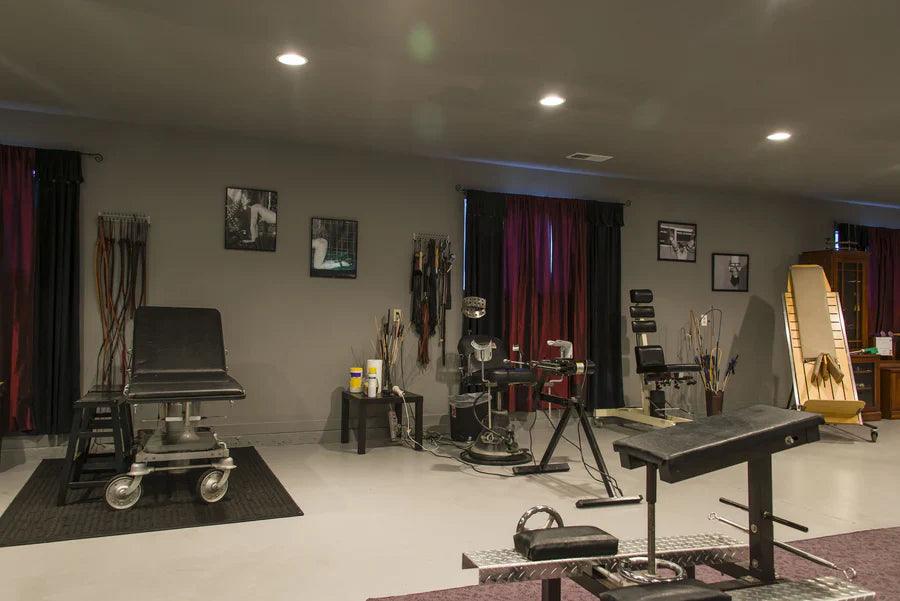
How to Choose the Right BDSM Furniture for Your Needs
Share
How to Choose the Right BDSM Furniture for Your Needs
An introductory guide for curious beginners and experienced enthusiasts alike
When it comes to exploring BDSM, having the right furniture can completely transform your experience—both in terms of comfort and creative possibilities. Whether you are just dipping a toe into the world of kink or you’ve been experimenting for years, it’s essential to make an informed choice. This guide will walk you through the key considerations, from understanding different pieces of furniture to figuring out which one is most suitable for your space, budget, and desired level of intensity.
1. Assessing Your Space and Lifestyle
Before diving into specific types of BDSM furniture, take a moment to evaluate the space where you plan to use it. Ask yourself:
-
How much room do I have available?
A small apartment might not accommodate a full-sized St. Andrew’s Cross or bulky stocks. Conversely, a dedicated room or large basement could be perfect for creating a more extensive setup. -
Do I need furniture that is easy to store or dismantle?
Some pieces can be folded or broken down for storage, which is a major bonus if discretion or limited space is a concern. -
Will my furniture serve multiple purposes?
Some designs are versatile enough to double as regular furniture or can be discreetly integrated into your bedroom aesthetic.
By being realistic about your home environment, you can focus on pieces that fit comfortably and don’t disrupt your day-to-day life—particularly if privacy is an issue.
2. Understanding the Basics: Common Types of BDSM Furniture
BDSM furniture can range from subtle and minimalist items to large, imposing structures. Below are some of the most common options you’ll encounter:
-
St. Andrew’s Cross
-
Description: Often shaped like an “X,” the St. Andrew’s Cross is used to restrain a partner (or be restrained yourself) at various angles.
-
Uses: Ideal for impact play, sensation play, and extended bondage scenes.
-
Considerations: Requires adequate ceiling height and floor space. Typically a more advanced piece that can serve as the centerpiece of a dedicated playroom.
-
-
Spanking Bench
-
Description: A padded bench (sometimes also called a “horse”) designed to position the body comfortably for impact play.
-
Uses: Perfect for spanking, flogging, or any activity where access to the posterior is a priority.
-
Considerations: Varying heights and angles can be more ergonomic. Look for stable construction, especially if intense play is anticipated.
-
-
Stocks
Description: Inspired by historical designs, stocks typically restrain either the wrists and neck or wrists and ankles, depending on the model.
Uses: Restrictive bondage and roleplay scenarios. Heightens vulnerability by limiting movement.
Considerations: Ensure comfortable padding around any contact points, and check that locking mechanisms are secure yet accessible for quick release.
-
Bondage Chair
Description: A chair with built-in straps, hooks, or loops to restrain arms, legs, and torso.
Uses: Ideal for detailed bondage scenarios or prolonged roleplay situations where the submissive is seated.
Considerations: Make sure you have enough space for a dedicated chair. If you prefer something that blends into regular décor, look for a more discreet design.
-
Modular or Collapsible Furniture
Description: Furniture designed to fold, stack, or be easily disassembled for storage.
Uses: Perfect for people without a permanent playroom, or those who value discretion.
Considerations: Check whether the collapsible mechanism is secure and whether the piece remains stable during intense use.
3. Factoring in Your Experience Level
Beginner BDSM enthusiasts often benefit from starting small. Think about more versatile, compact pieces (like a lightweight spanking bench or a collapsible piece of furniture) that allow you to explore different types of play without committing to a large investment or taking up too much space. As you gain confidence, you might progress to bigger items like the St. Andrew’s Cross.
Advanced practitioners may already have a strong sense of the sensations and positions they enjoy. If you’re at this stage, opting for specialized, high-quality furniture that caters to specific kinks might be your next step. You may want more than one piece to create varied scenarios—a bondage chair for intricate rope work and a St. Andrew’s Cross for upright play, for example.
4. Budgeting for Quality and Longevity
BDSM furniture can range from very affordable to extremely high-end. High-quality craftsmanship is especially important when dealing with pieces designed for restraint or impact play. Consider:
-
Materials: Look for solid wood or sturdy metal frames for durability. Padded areas should be made with easy-to-clean, body-safe materials (often vinyl or leather).
-
Construction: Joints, screws, and anchor points must be designed to withstand weight and movement. If a piece looks flimsy or “wobbles,” it’s likely an unsafe choice.
-
Brand Reputation: Buying from reputable makers ensures the product has been tested for reliability and comfort. Checking reviews or seeking recommendations in BDSM communities can be a great way to find trustworthy sources.
Keep in mind that quality furniture is an investment in your safety and satisfaction. While budget options exist, never compromise on safety features. Well-built items will offer peace of mind and last much longer, making them cost-effective over time.
5. Comfort, Aesthetics, and Personal Taste
Beyond practicality and safety, your furniture should also match your personal style and enhance the ambiance you’re trying to create. Think about:
-
Aesthetic Appeal: Do you prefer a sleek, modern look with metal and leather? Or are you more drawn to the warmth of polished wood and subtle curves?
-
Customizable Options: Some artisans offer color choices, material upgrades, or decorative finishes to help your piece blend into your existing décor.
-
Ergonomic Design: Seek out designs with strategic padding and adjustable restraints to ensure comfort during longer sessions.
Remember, this furniture might become a focal point in your space, so choose something that resonates with you. The more you enjoy how it looks and feels, the more inclined you’ll be to use it often and creatively.
6. Testing and Trial
If possible, experience BDSM furniture in person before buying. Many kink events, workshops, or community dungeons have a variety of pieces available for participants to try. Pay attention to factors like:
-
Height and Positioning: Does the furniture fit your body comfortably, or do you feel awkwardly stretched?
-
Sturdiness: Do you notice any structural instability or uncomfortable vibrations during use?
-
Adjustability: Can you easily make adjustments to accommodate different body sizes or positions?
If an in-person test isn’t possible, look for detailed product reviews or reach out to the manufacturer with any questions you have about fit or functionality.
7. Essential Safety Tips
No matter which piece of BDSM furniture you choose, proper safety measures remain a must:
-
Safe Words and Communication
Agree on clear signals (verbal or nonverbal) to pause or stop play.
-
Check in frequently with your partner, especially if they are restrained and cannot easily communicate distress.
-
-
Setting Boundaries
Discuss limits in advance, including what sensations and positions are off-limits.
-
Start slowly, especially with new furniture, and gradually increase intensity as you get comfortable.
-
-
Regular Maintenance
Inspect furniture for loose screws, cracks, or worn straps.
-
Clean and disinfect surfaces between uses to maintain hygiene and prolong durability.
-
By taking a conscientious approach, you can fully enjoy your BDSM adventures without unnecessary risks.
8. Making the Final Decision
Choosing the right BDSM furniture is part research and part intuition. Begin by identifying your space constraints, personal tastes, budget, and experience level. From there, narrow down potential options—maybe a sturdy spanking bench for an intimate bedroom setup or a show-stopping St. Andrew’s Cross if you have the space and love dramatic impact play.
Ultimately, the goal is to select furniture that enhances your erotic exploration, fuels your creativity, and respects your comfort and safety. Whether you’re brand-new to the scene or a long-time devotee, investing in quality, well-chosen BDSM furniture can open the door to a world of thrilling possibilities—one well-placed restraint at a time.
BDSM furniture serves as both a practical tool for safer, more comfortable play and an aesthetic statement that transforms an ordinary room into a realm of erotic adventure. By assessing your space, thinking about your needs and desires, and focusing on quality construction, you’ll be poised to choose the perfect piece that elevates your BDSM experiences. With open communication, mindful budgeting, and a focus on safety, you’ll have all the ingredients for an exciting journey into the world of kink—where the right furniture can make all the difference.
